PagerDuty Mobile App
The PagerDuty mobile app allows users to respond to incidents, view account objects and manage settings on the go, wherever you are.
Download the Mobile App
The PagerDuty mobile app is available in the Apple Store and Google Play. Download the app by searching for PagerDuty in either app store, or you may tap one of the buttons below from your mobile device:
Supported Operating Systems and Configuration
As of April 2025, the PagerDuty mobile app is supported on devices running iOS 17 and higher, or Android 12 and higher. You may not have access to the latest features if your device does not meet minimum requirements.
Rooted devices are not supported:
As of March 18, 2024, PagerDuty has enhanced its security measures by discontinuing support for the PagerDuty mobile app on rooted and jailbroken devices. Additionally, PagerDuty will no longer support emulators and tampered versions of the app. This update strengthens our commitment to security, ensuring the integrity of our services, and aligning with our dedication to maintaining FedRAMP compliance.
Log in to the Mobile App
You will log in to the mobile app by entering the email address associated with your PagerDuty user account. The app will then guide you through the rest of the login process and present you with the most relevant options. Please read Log In to PagerDuty for more information.
Log in to Multiple PagerDuty Accounts in the Mobile App
- After you have logged in to one PagerDuty account, you may add other accounts to the app by navigating to More in the top-left.
- Tap at the top-right (iOS) or bottom-right (Android). If prompted, select the Environment you would like to open the account in.
- Log in to the additional account. After you are logged in, you will be able to see it in the list of accounts at More .
PagerDuty for Intune
Please note that PagerDuty for Intune users cannot log in to multiple PagerDuty accounts in the mobile app.
Switch PagerDuty Accounts in the Mobile App
- After you have logged in to multiple PagerDuty accounts in the mobile app, you can find each account by navigating to More .
- To switch to another account, navigate to More and tap the desired account
Remove a PagerDuty Account in the Mobile App
iOS
To remove an account from the iOS mobile app:
- Navigate to More .
- Tap Edit, then tap next to the account you'd like to remove.
- Tap Delete, then Remove to confirm your selection.
Android
To remove an account from the Android mobile app:
- Navigate to More .
- Tap to the right of the account you'd like to remove, and select Remove this Account.
- Tap Remove to confirm your selection.
Mobile App Walkthrough
Menu options are located at the bottom of the screen:
- Home
- Incidents
- My Shifts
- Services
- More
- Escalation Policies
- Resolved Incidents
- Schedules
- Status Dashboard
- Teams
- Users
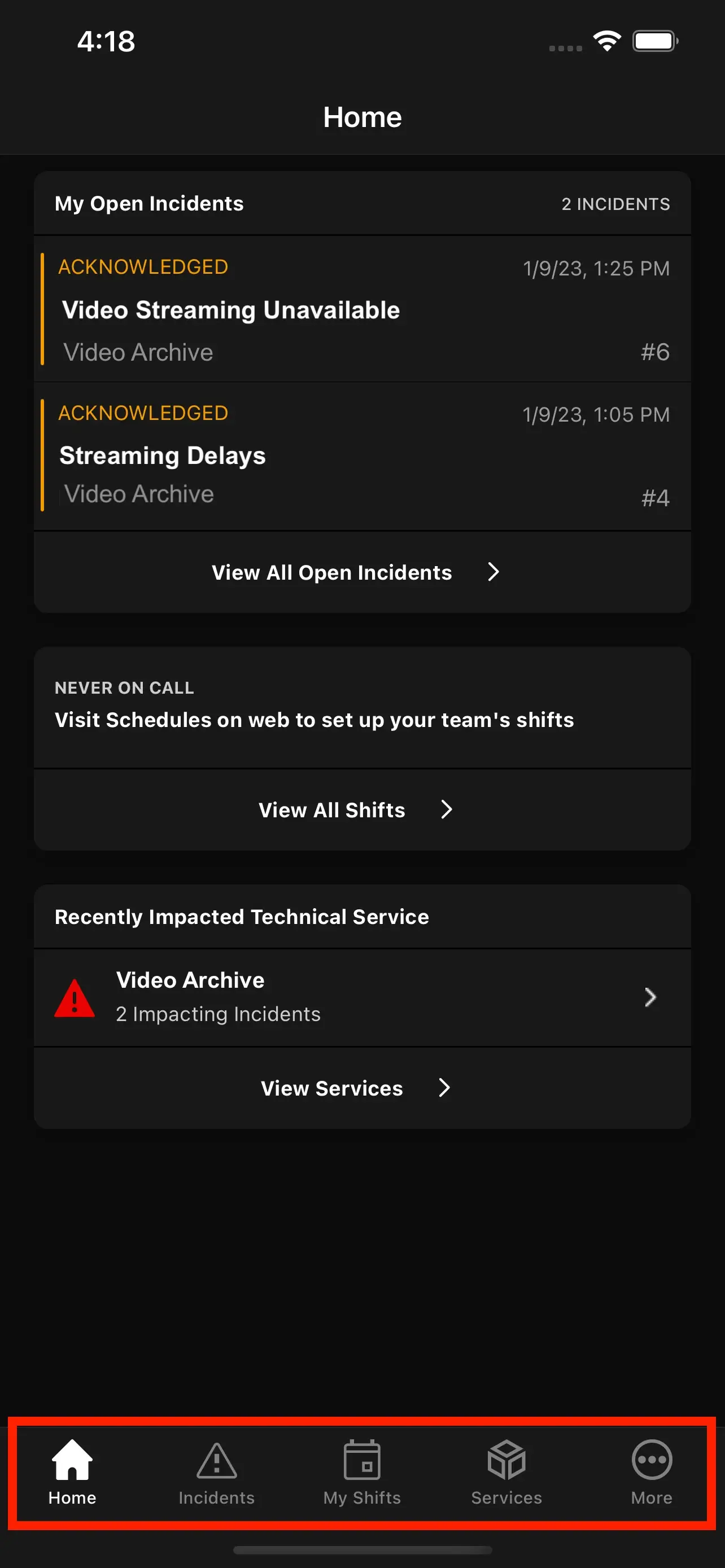
PagerDuty mobile app navigation
The app will remember which tab you were on when you navigate away. For example, if you were on the Incidents tab viewing an incident Timeline and then you switched to the Services tab, when you return to the Incidents tab you would still be viewing that incident's Timeline.
Home Screen
The mobile Home screen highlights top open incidents, and displays on-call shifts and service information, which broadens awareness and streamlines navigation to other important, non-incident information. Please read Mobile Home Screen for more information.

Mobile Home Screen
Open Incidents Screen
To view open incidents, select Incidents from the bottom navigation.
The Mine tab shows all triggered and acknowledged incidents assigned to you. The All tab shows all triggered and acknowledged incidents in the account. If you have a Responder role or higher, you will also see the My Teams tab, which will show all incidents assigned to your teams.
This screen remembers your tab selection (i.e., Mine, My Teams or All), so you can access relevant incidents faster when navigating here from other screens.
Sort Incidents
You may sort open incidents by tapping Sort By [x] and selecting Urgency, Priority or Recent.
If you sort by urgency, high urgency incidents will be displayed at the top of the queue and low urgency incidents at the bottom, regardless of their status (i.e., triggered or acknowledged).
Trigger an Incident
To trigger an incident in the mobile app:
iOS
- Navigate to Incidents at the bottom of the screen, tap in the top-right, and select New Incident.
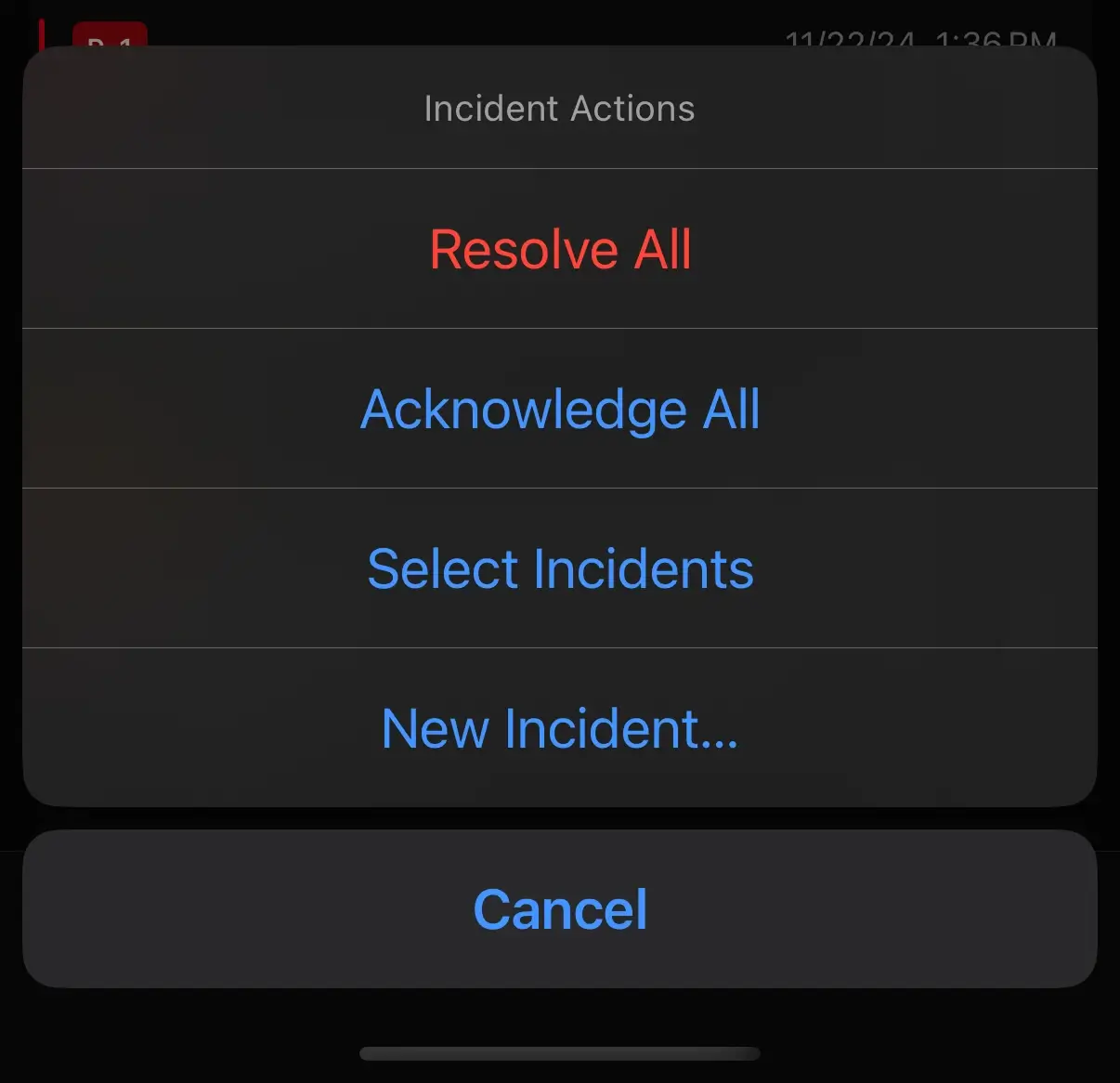
Trigger an incident
-
Enter the following:
- Name: A meaningful name for the incident.
- Description (optional): A meaningful description of the incident.
- Incident Type: Select an incident type.
- Service: Select the affected service.
- Assign to (optional): You may select an escalation policy or user other than the service's default escalation policy. This overrides who the incident is assigned to.
- Priority (optional): Add an Incident Priority, if needed.
-
Tap Create in the upper-right to trigger the incident.
Android
- Navigate to Incidents at the bottom of the screen, tap in the top-right, and select New Incident.
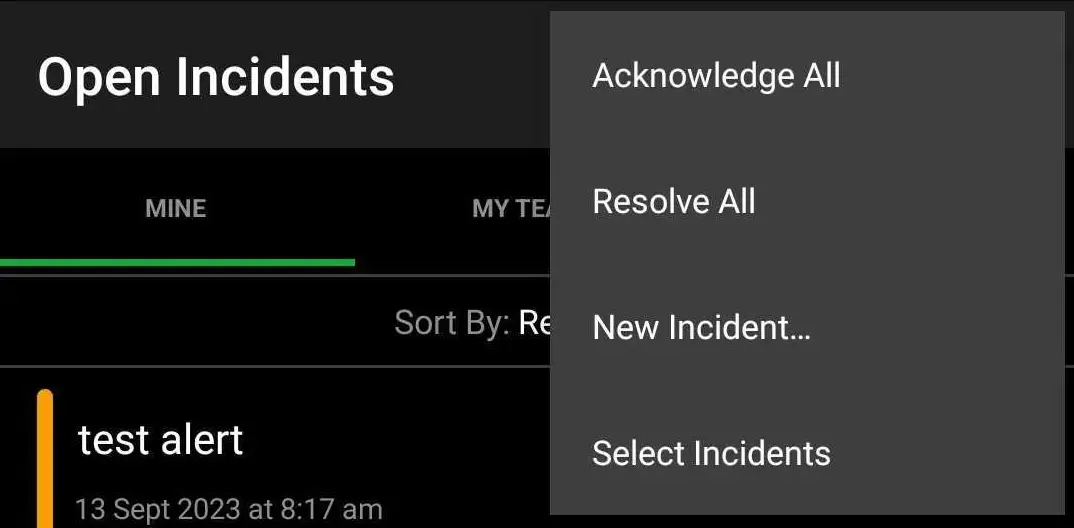
Trigger an incident
-
Enter the following:
- Title: A meaningful name for the incident.
- Incident Type: Select an incident type.
- Impacted Service: Select the affected service.
- Description (optional): A meaningful description of the incident.
- Assign to (optional): You may select an escalation policy or user other than the service's default escalation policy. This overrides who the incident is assigned to.
- Priority (optional): Add an Incident Priority, if needed.
-
Tap Create Incident.
Respond to Incidents in the Mobile App
Tap Incidents in the bottom navigation to see a list of all open incidents.
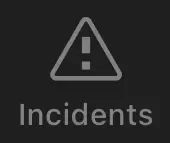
Incidents icon
Acknowledge an Incident
If a triggered incident is assigned to you, the banner at the top will turn red. Your incidents will be under the Mine tab on the Open Incidents screen. There are three ways to acknowledge an incident:
- Swipe left on the incident and tap Ack.
- You can also tap the incident and then tap the Ack button at the bottom of the incident details page.
- Or you can acknowledge directly from a push notification by long pressing and tapping Ack (iOS). PagerDuty push notifications provide the incident number, service, and incident description.
After you acknowledge the incident, the banner will turn yellow.
Snooze an Incident
There are two ways to snooze an incident in the mobile app:
- After an incident is acknowledged in the incident details page, the Ack button becomes a Snooze button.
- You can also snooze an incident by swiping left on an acknowledged incident.
Resolve an Incident
iOS
There are two ways to resolve an incident:
- Tap an incident to enter the details screen and tap Resolve at the bottom of the screen.
- On the Open Incidents page, swipe left on an incident an tap Resolve.
Android
There are two ways to resolve an incident:
- Tap an incident to enter the details screen and tap Resolve at the bottom of the screen.
- On the Open Incidents page, swipe right on an incident.
Incident Details and Other Actions
Tap an incident to enter the incident details screen. The incident details screen contains incident information, timeline and a status updates section.
Triage Tab
Tap the Triage tab to view the details of the incident as well as easily execute different PagerDuty actions:
- Automation Actions: Run an Automation Action.
- Run a Workflow: Run an Incident Workflow.
- Add Priority: Add a priority level to the incident.
- Custom Incident Actions: If your account has any custom incident actions configured, you will see those specific actions as buttons.
- Add Note: Add a note to the incident.
- Status Update: Post a status update.
- Edit Title: Edit the incident’s title.
- Change Service: Reassign the incident's service.
- Change to [Urgency Level]: Change the urgency level from high to low or vice versa.
- Add Responder: Add responder(s) to the incident.
- Reassign: Reassign the incident to a different escalation policy or user.
- Escalate: Escalate the incident to a different user on the escalation policy.
Overview Tab
Tap the Overview tab to view the following incident details:
- Impacted Service: The service impacted by this incident. Tap the service name to see the service’s details.
- Responders: Responder(s) currently responding to the incident. You may take the following actions:
- View Responder Details: Tap a responder’s name to view more details.
- Escalate: Escalate the incident to the next responder on the escalation policy
- Add Responder: Add more responders to the incident.
- Reassign: Reassign the incident to a different escalation policy or user.
- Conference Bridge: If your account has a conference bridge configured, you will see options to join the bridge and/or meeting link.
- Latest Status Update: Status updates for the incident.
- [#] Subscribers: Users who are subscribed to the incident. To send a status update to subscribers, tap Post Status Update, enter your status update and then tap the in the upper right.
- Timeline: An abridged incident timeline with the latest updates. Tap View Timeline to see the entire incident timeline.
- Triggered Alerts: Alerts for the incident.
- Past Incidents: Past incidents related to the current incident.
All Actions Button
The All Actions button provides quick and easy access to the actions available in the Triage tab as well as the following incident actions:
- Snooze: Snooze the incident.
- Unacknowledge: Unacknowledge the incident if you previously acknowledged it.
- Subscribe: Subscribe to the incident.
Custom Fields
The Custom Fields feature allows users to enrich PagerDuty incidents with critical and helpful metadata throughout the incident lifecycle. Please read Custom Fields on Incidents for more information.
Related Incidents
Availability
The Related Incidents feature is currently available with the PagerDuty AIOps add-on. If you would like to sign up for a trial of this and other PagerDuty AIOps features, please read PagerDuty AIOps Trials.
On the incident details screen, you can select the blue Related Incidents button to review suggested incidents that are impacting other responders and PagerDuty services.
You can select an incident under the Related Incidents list, which will open the corresponding incident details screen. Tap to return to the original incident.
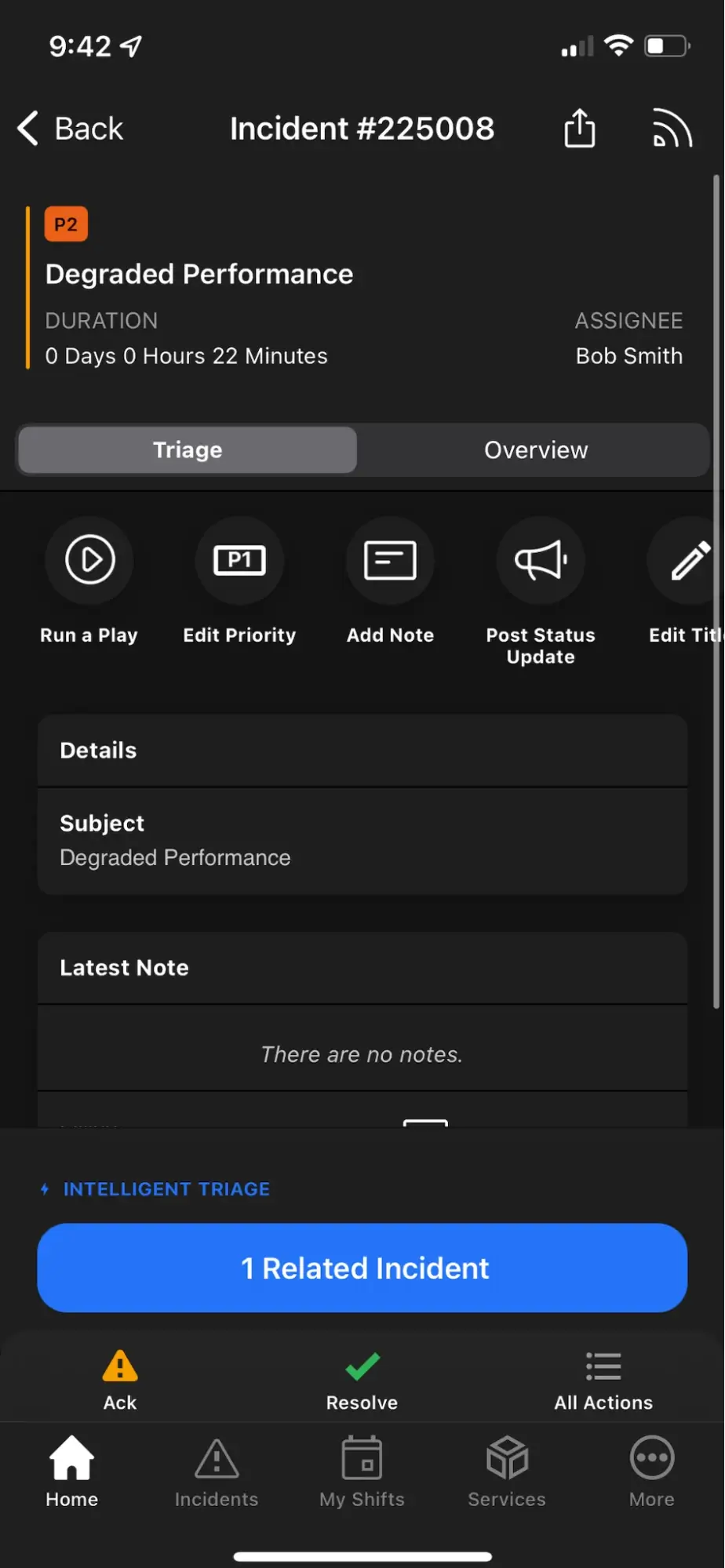
Related incidents
Resolved Incidents Screen
Navigate to More Resolved Incidents to view list of all resolved incidents. Tap an incident to view its details. Select the My Teams tab to see incidents related to your Teams, or select the All tab for all incidents across the whole account.
Service Directory Screen
Select Services in the bottom navigation to view the Service Directory. The Service Directory is a searchable, high-level view of all PagerDuty services in your organization, and their corresponding owners.
To search the Service Directory screen, tap in the upper right and search by service name.
To filter services, select the My Teams tab for services related to your Teams, or the All tab for all services account-wide.
Tap a service to view its details:
- Incidents: Open incidents occurring on the service.
- On Call Now: Responders who are currently on call on the service’s escalation policy.
- Team: The Team associated with the service.
- Description: The service’s description.
- Escalation Policy: The escalation policy associated with the service.
- Dependencies: Services that have dependencies on the current service in the Uses and Used By directions.
- Change Events: Recent change events related to the service.
Users Screen
Navigate to More Users to view a list of users and their login email addresses. Select a user to show their contact methods and escalation policies where they are on-call.
To search for a user, tap in the top right and search for their name or email address. You can email, call, or SMS a user from your device by tapping on a user's email address or phone number.
On Android, tap to Add to Contacts or Edit Schedule Color.
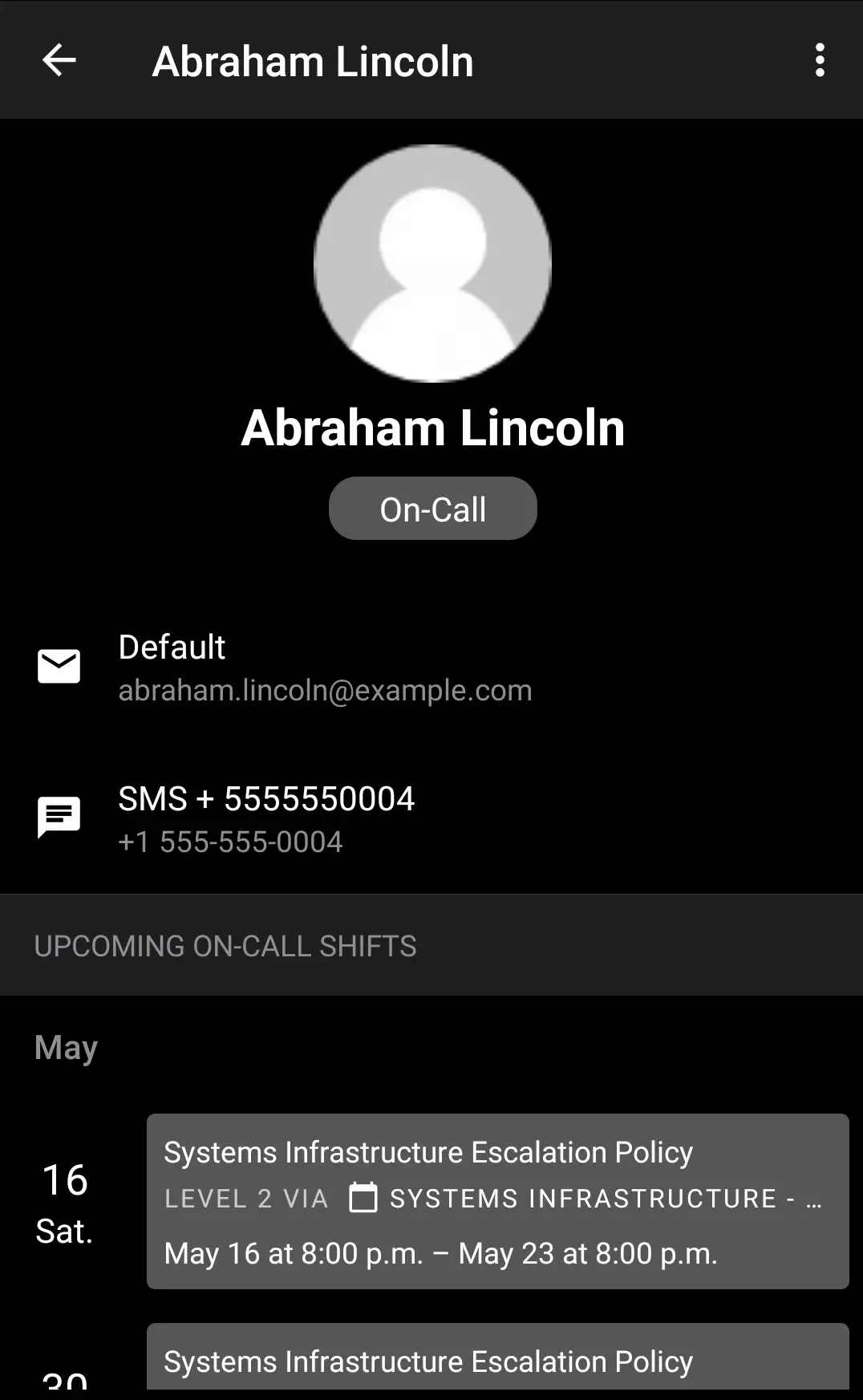
Users screen
Schedules Screen
Navigate to More Schedules to view a list of schedules in your account. Tap a schedule to view its details. On the details screen you will see a calendar and list of upcoming on-call shifts. Move forward and backward in the schedule using and , and tap a date to view who is on call for that day. Tap in the top-right to return to today's date.
To search schedules, tap in the upper-right and search by schedule name.
To filter schedules, you may select the My Teams tab for schedules related to your Teams, or the All tab for all schedules account-wide.
Schedule Overrides
iOS
- To schedule an override, navigate to More Schedules and select your desired schedule.
- In the list of shifts, tap the shift you would like to override.
- By default, you will be set as the user overriding the shift. If you would like another user to override the shift, tap your name and select another user from the list.
- Note: You can enter a search term on the user list screen to limit results.
- Optional: If needed, tap Starts and/or Ends to adjust the override's duration. You can also tap Duration to select a predetermined override length:
- 1 hour
- 6 hours
- 12 hours
- 24 hours
- Until the rotation ends
- Tap Override in the top-right. Tap Override again in the confirmation modal.
Android
- To schedule an override, navigate to More Schedules and select your desired schedule.
- In the list of shifts, tap the shift you would like to override.
- By default, you will be set as the user overriding the shift. If you would like another user to override the shift, tap your name, select another user from the list, and tap Done in the top-right.
- Note: You can tap and enter a search term on the Select User screen to limit results.
- Optional: If needed, tap the start date, end date, start time, and/or end time to adjust the override's duration. You can also tap the Override Length to select a predetermined override duration:
- 1 hour
- 6 hours
- 12 hours
- 24 hours
- Until the rotation ends
- Tap Override in the top-right. Tap Override again in the confirmation modal.
Escalation Policies Screen
Navigate to More Escalation Policies to view your account’s escalation policies. Selecting an escalation policy will show who is on-call at each level. Select a user to see their contact info and schedule details.
My On-Call Shifts Screen
Tap My Shifts in the bottom navigation to view My On-Call Shifts. My On-Call Shifts will display escalation policies that you are on call for and your upcoming shifts for the next month.
To view more details about the escalation policy, tap your shift and then tap Go to Escalation Policy.
Status Dashboard Screen
Navigate to More Status Dashboard to view the incident status of all Business Services in your account. If your account has custom dashboards configured, you may switch dashboard views by tapping in the top-right and selecting your preferred dashboard.
To view more details about a Business Service, tap its name. On the details screen, you will be able to view supporting services. To view more details about a supporting service, tap its name.
To subscribe to a Business Service, tap the business service’s name and then tap in the top right.
Settings Screen
Navigate to More in the top right to view the Settings screen. Here you can select a custom push notification sound, as well as sounds for high and low-urgency notifications.
For more information on notification configuration options, please see Mobile App Settings.
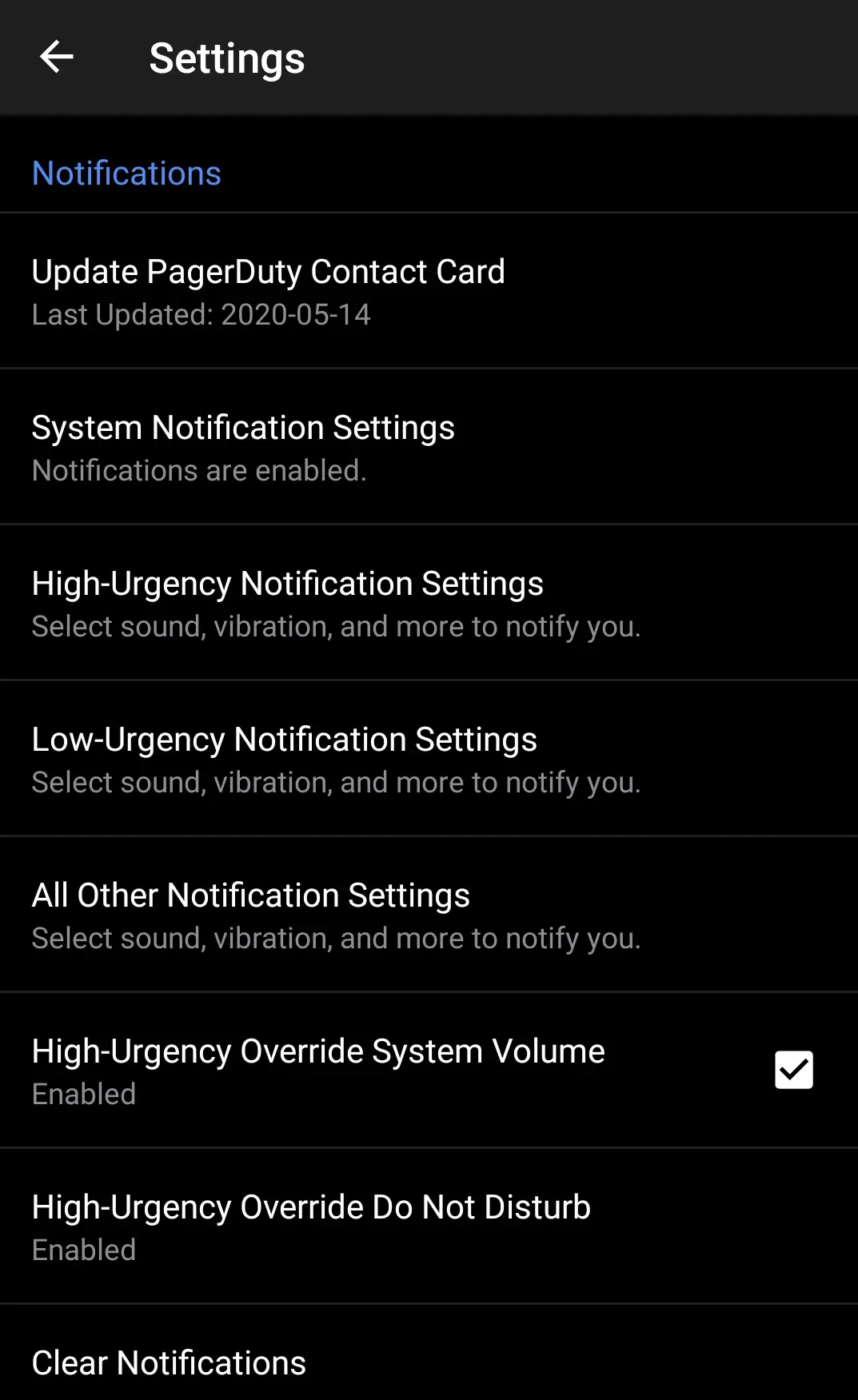
Settings in the mobile app
Mobile App Permissions
New downloads of the mobile app will ask for the permission to access your contacts the first time you log in. Existing app users can access this under on the mobile app's Settings screen under Automatic Contact Card Management.
We use request access to your contacts so that the app can import the PagerDuty vCard, which lets you know that a phone or SMS notification is from PagerDuty. The vCard is automatically automatically kept up to date whenever a number is added or removed from the vCard.
- We will not send messages, calls, or notifications to any contact within your contacts list.
- We will not use this permission for marketing, data gathering, or for research purposes.
If you deny this permission, the app will still function as intended. However, you may miss calls if a PagerDuty phone number is blocked or marked as spam by your provider. For iOS users, installing the vCard allows you to enable an override for Do Not Disturb, and will ensure silencing unknown numbers doesn't affect calls from PagerDuty. You can also manually download the vCard from our Knowledge Base, however you will need to periodically check to see if it has been updated, and if so, you’ll need to download it again.
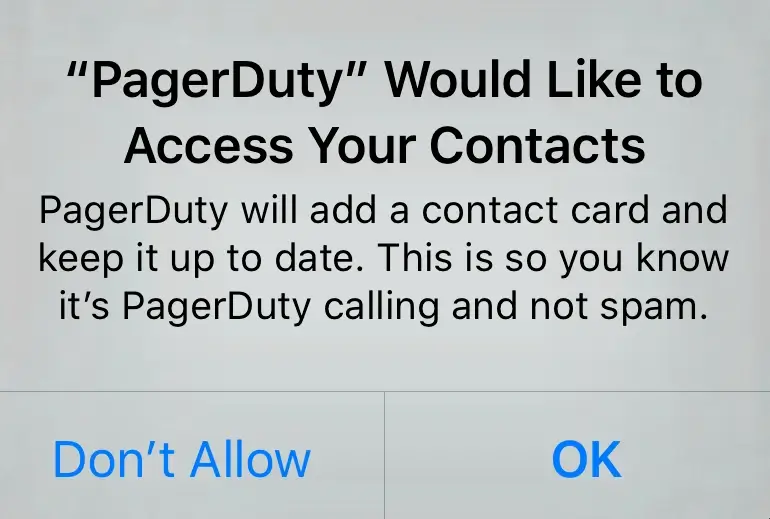
Mobile app permissions
Advanced Mobile Security
Add an additional layer of mobile app security by setting up Advanced Mobile Security on your PagerDuty account.
Enabling this feature will require users to set a passcode (i.e., PIN) after logging in to the mobile app. This passcode is stored locally on the user’s device and will need to be entered to access the app every time users close it or leave it in the background. On iOS, users can choose to use phone biometric features like Face ID. Administrators can also set a timeout which will additionally require the passcode when the timeout has elapsed even if the user has not minimized or closed the app.
Requirements
The App Lock feature is available to customers on the following pricing plans: Business, Digital Operations (legacy) and Enterprise for Incident Management.
Note: Advanced Mobile Security is configured in the web app as opposed to the mobile app.
To set up App Lock:
- In the PagerDuty web app, navigate to User Icon Account Settings Mobile Security Settings.
- Select On from the Mobile App Lock Setting dropdown.
- Enter an App Lock Timeout value in minutes, which will determine how long it should take before the app locks itself and requires the user to enter their passcode.
- Click Save.
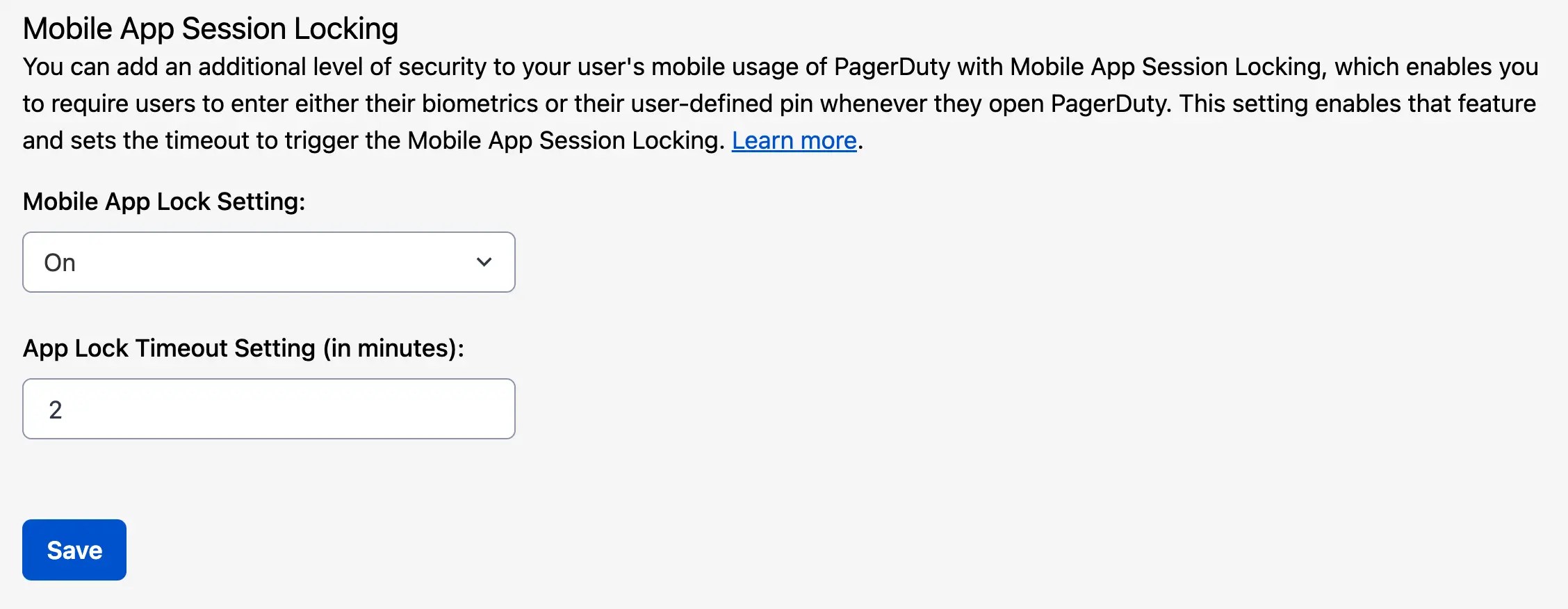
Mobile security settings
After the setting is enabled, users will be prompted to enter a new passcode when they log into their PagerDuty mobile app.
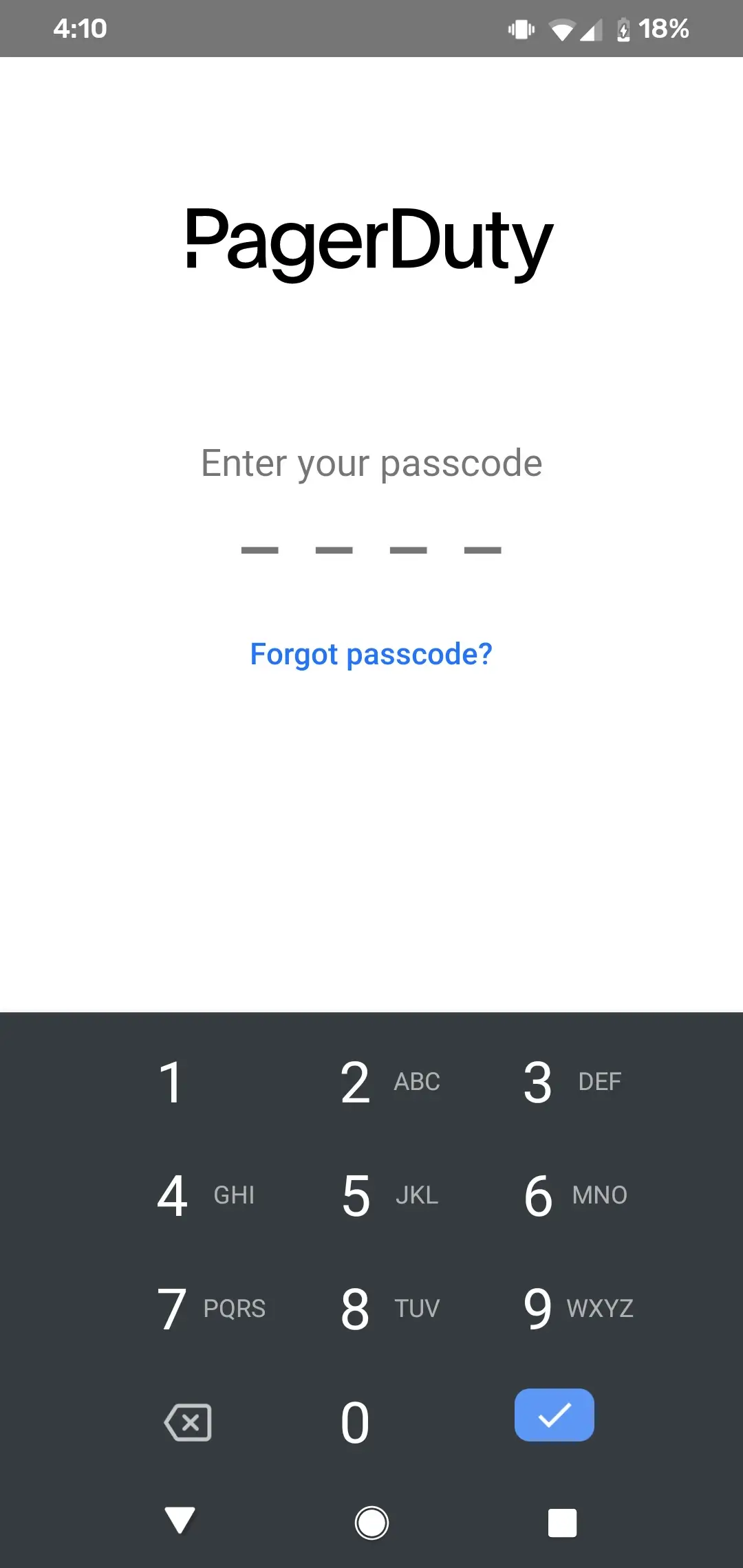
Login passcode
Reset Passcode
If you have forgotten your passcode or would like to change it, you can click Forgot passcode?, which will log you out of the entire app to set up a new one.
FAQ
When logging in, do I need to select my service region?
You do not need to specify your Service Region (i.e., US or EU) when logging in. The login system works globally, and will log you in to the appropriate account depending on the credentials you enter. If you use the same email/password combination for accounts in both EU and US regions, you will be presented with a list of accounts, which will indicate each account's service region.
I use Single Sign-On to log in. Why don’t I see the option to enter my email/password, too?
Your PagerDuty administrator has configured the account to only allow login via single sign-on. Please contact your PagerDuty administration if you wish to use email and password to sign in to PagerDuty.
I have multiple accounts with the same email. Why don't I see a list of accounts to log into?
Users will see a list of accounts that use the exact same email/password combination. If you have used different passwords, but the same email address, for different accounts, the app will not present a list of accounts.
Can I use a password manager to log in?
Yes, the PagerDuty mobile app is compatible with industry standard password managers, even if you have multiple PagerDuty accounts. If you use a unique password for each PagerDuty account, the app will log you in to the appropriate account.
If I have multiple PagerDuty accounts, should I use the same password for each?
No, we do not recommend using the same password across multiple accounts for security reasons.
Updated 5 months ago

